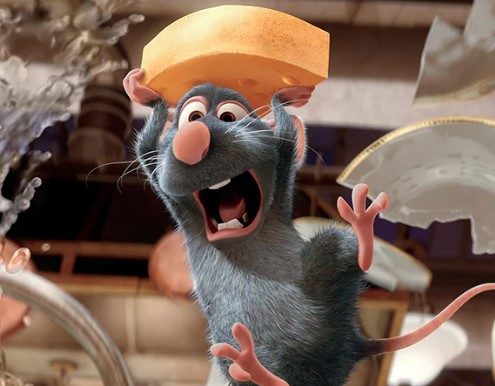Often, when we’re taught about our own biology in grade school we’re taught about one process at a time – the respiratory system, the cardiovascular system, the nervous system; each of these taught individually and often separately from all the other systems in our bodies. Even our senses – sight, smell, taste, touch, and hearing – are often taught to children individually. It is only much later, that we begin to put together the complex puzzle to see how the systems and senses of our bodies work together, supporting each other, and creating multidimensional experiences unique and essential to our lives.
Consider for a moment the Pixar movie Ratatouille. Remi, the main character, is a rat of unique talent. His senses of smell and taste are more sensitive than those of his rat family. He’s put to work by his father, sniffing out any bit of poison in the food that they’ve scavenged. But when he gets separated and lost, his world is opened to new possibilities. Suddenly his love of food is embraced by his new human companion, Linguini, and together they make dishes and recipes that astound even the harshest of critics. Despite the limitations of the movie industry not being able to put the real plate of food in front of the viewer to smell and taste, the animators find other ways to communicate the creativity of Remi’s palate. When he tastes an ingredient a note is played and a colorful brush stroke appears on the screen. When he adds a second or third ingredient the note turns into a chord and the bit of color turns into a piece of art. For Remi, and then for the viewer, the senses work together to create a more full experience letting an animated movie jump off the screen and into a beautiful and complicated world.
Synesthesia, the process of activating multiple senses with a singular input, like Remi’s is relatively rare in humans. Most of us don’t see colors when we taste a strawberry or hear sounds when we hold a spoon. But our senses do work together in other ways, whether it’s through a smell activating a memory or a sight creating a sense of awe. In fact, we’re taught even from the very beginning that the various senses and systems of our bodies are essential for witnessing the divine in our world.
This week we re-read the Israelites camping at the bottom of Mount Sinai in preparation for their decisive revelatory experience. Moses as their agent ascends the mountain to receive the commandments and teaching of God, while the Israelites remain below, witnessing only thunder and lightning. But the Hebrew of the text is a little more complicated than that. It says that the people “roh-im et ha-kolot v’et ha-lapidim, v’et kol ha-shofar,” they saw thunder, saw lightning, and saw the voice of the shofar. They saw sounds, which quickly overwhelmed and scared them. They associated this synesthetic experience with an experience of the divine and worried that something so outside of their normal sensory experience would kill them. But Moses reassures them. “Do not fear,” he says, “God is only trying to prove to you that God can come near and fill you with awe.”
When our bodies work in new and unexpected ways it can indeed be frightening. When our senses are overcharged, or our limbs move without conscious thought, or our brains process information in nontraditional patterns we can become so overwhelmed that our first instinct is to back away. But at Sinai and every day afterward, God tells us to fight that temptation. When our bodies and experience break so-called convention, those are the moments we have extra access to the divine.
This month of Jewish Disabilities Awareness, Advocacy, and Inclusion Month (JDAAIM) and this Kabbalat Shabbat for our Scott B. Crane Abilities Awareness worship we celebrate those moments and those individuals in whom we are all inspired to see the divine. Each of our bodies works in unique ways, and in getting to know how one body differs from another we learn more about ourselves and our connection to the divine spark that lives within us all. Whether that difference is visible or invisible, overt or subtle, seeking out difference leads to revelation. Like the Israelites at Sinai, we are commanded to open ourselves, our bodies, and our experiences to the multitude of ways a human body works. When we follow that divine teaching, we gain access to a more meaningful, spiritual, and purposeful way of living.

